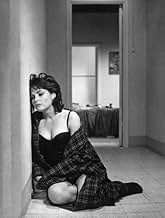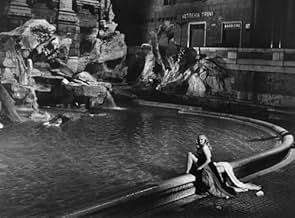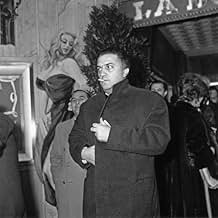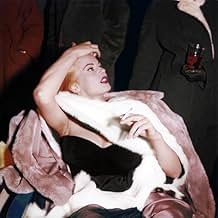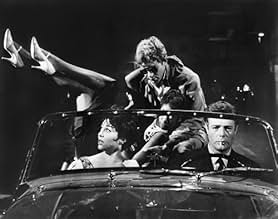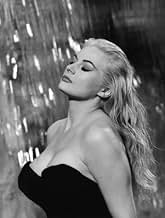Uma série de histórias que se seguem por uma semana, a vida de um jornalista que mora em Roma.Uma série de histórias que se seguem por uma semana, a vida de um jornalista que mora em Roma.Uma série de histórias que se seguem por uma semana, a vida de um jornalista que mora em Roma.
- Direção
- Roteiristas
- Artistas
- Ganhou 1 Oscar
- 11 vitórias e 12 indicações no total
Anouk Aimée
- Maddalena
- (as Anouk Aimee)
Magali Noël
- Fanny
- (as Magali Noel)
Resumo
Reviewers say 'La Dolce Vita' delves into themes of fame, decadence, and the superficiality of celebrity culture, using these characters to underscore the contrasts and contradictions within high society. The portrayal of it's characters enhances the film's satirical and critical perspective on the lifestyles and attitudes of the era, offering a nuanced commentary on the nature of fame and its impact on individuals and society.
Avaliações em destaque
LA DOLCE VITA presents a series of incidents in the life of Roman tabloid reporter Marcello Rubini (Marcello Mastroianni)--and although each incident is very different in content they create a portrait of an intelligent but superficial man who is gradually consumed by "the sweet life" of wealth, celebrity, and self-indulgence he reports on and which he has come to crave.
Although the film seems to be making a negative statement about self-indulgence that leads to self-loathing, Fellini also gives the viewer plenty of room to act as interpreter, and he cleverly plays one theme against its antithesis throughout the film. (The suffocation of monogamy vs. the meaninglessness of promiscuity and sincere religious belief vs. manipulative hypocrisy are but two of the most obvious juxtapositions.) But Fellini's most remarkable effect here is his ability to keep us interested in the largely unsympathetic characters LA DOLCE VITA presents: a few are naive to the point of stupidity; most are vapid; the majority (including the leads) are unspeakably shallow--and yet they still hold our interest over the course of this three hour film.
The cast is superior, with Marcello Mastroianni's personal charm particularly powerful. As usual with Fellini, there is a lot to look at on the screen: although he hasn't dropped into the wild surrealism for which he was sometimes known, there are quite a few surrealistic flourishes and visual ironies aplenty--the latter most often supplied by the hordes of photographers that scuttle after the leading characters much like cockroaches in search of crumbs. For many years available to the home market in pan-and-scan only, the film is now in a letterbox release that makes it all the more effective. Strongly recommended.
Gary F. Taylor, aka GFT, Amazon Reviewer
Although the film seems to be making a negative statement about self-indulgence that leads to self-loathing, Fellini also gives the viewer plenty of room to act as interpreter, and he cleverly plays one theme against its antithesis throughout the film. (The suffocation of monogamy vs. the meaninglessness of promiscuity and sincere religious belief vs. manipulative hypocrisy are but two of the most obvious juxtapositions.) But Fellini's most remarkable effect here is his ability to keep us interested in the largely unsympathetic characters LA DOLCE VITA presents: a few are naive to the point of stupidity; most are vapid; the majority (including the leads) are unspeakably shallow--and yet they still hold our interest over the course of this three hour film.
The cast is superior, with Marcello Mastroianni's personal charm particularly powerful. As usual with Fellini, there is a lot to look at on the screen: although he hasn't dropped into the wild surrealism for which he was sometimes known, there are quite a few surrealistic flourishes and visual ironies aplenty--the latter most often supplied by the hordes of photographers that scuttle after the leading characters much like cockroaches in search of crumbs. For many years available to the home market in pan-and-scan only, the film is now in a letterbox release that makes it all the more effective. Strongly recommended.
Gary F. Taylor, aka GFT, Amazon Reviewer
Mostly because of the terrific high contrast, B&W visuals, and the evocative music, this is the only Fellini film I have seen that I have somewhat enjoyed. I recommend it, but not without reservations. It's a complex film with many textured layers of meaning. And, in typical Fellini fashion, it rambles and it meanders.
Deviating from standard three-Act structure, Fellini's story consists of roughly eight episodes, all starting at night and ending at dawn, more or less. Each has its own crisis. And the only thing that unites these episodes into a coherent whole is the story's protagonist, Marcello (Marcello Mastroianni). In his job as a journalist and overall observer of human nature, Marcello encounters people in high society who seem outwardly happy and self-fulfilled. On closer examination, however, these people are empty, hollow, alienated, emotionally adrift and vacant.
A good example is the starlet Sylvia (Anita Ekberg), a glamorous figure, but she's all image and no substance. "La dolce vita" is the first film that uses the concept of "paparazzi", which implies the importance of "image", separate from substance.
Throughout the various episodes Marcello sees these "images" of happiness, of contentment, but the images are deceptive, elusive, unreliable. In one episode, two "miracle" children "see" the Madonna. "The Madonna is over there", shouts one child. The crowd chases after her. But the other child who "sees" the Madonna runs in the opposite direction. Happiness, self-fulfillment, religious visions ... they're all a will-o'-the-wisp. And so, the film conveys a sense of pessimism and cynicism.
The film thus has deep thematic value. It caused a scandal when it was released, and was banned by the Catholic Church, apparently for appearing to be anti-religious.
Yet for all its deep meaning, "La dolce vita" can be a trial to sit through. Somewhere in the second half I began to lose interest. I don't have a problem with Fellini's deviation from standard plot structure. I do have a problem with a director who doesn't know when to quit. This film goes on for almost three hours. A good edit, to delete all the fat, would have tightened up the story and rendered it more potent. As is, it's too strung out, too stretched, too meandering.
If the viewer can persevere, there's enormous cinematic art in this film. And helped along by Nino Rota's music, the film is wonderfully evocative, at times stylishly melancholy.
Deviating from standard three-Act structure, Fellini's story consists of roughly eight episodes, all starting at night and ending at dawn, more or less. Each has its own crisis. And the only thing that unites these episodes into a coherent whole is the story's protagonist, Marcello (Marcello Mastroianni). In his job as a journalist and overall observer of human nature, Marcello encounters people in high society who seem outwardly happy and self-fulfilled. On closer examination, however, these people are empty, hollow, alienated, emotionally adrift and vacant.
A good example is the starlet Sylvia (Anita Ekberg), a glamorous figure, but she's all image and no substance. "La dolce vita" is the first film that uses the concept of "paparazzi", which implies the importance of "image", separate from substance.
Throughout the various episodes Marcello sees these "images" of happiness, of contentment, but the images are deceptive, elusive, unreliable. In one episode, two "miracle" children "see" the Madonna. "The Madonna is over there", shouts one child. The crowd chases after her. But the other child who "sees" the Madonna runs in the opposite direction. Happiness, self-fulfillment, religious visions ... they're all a will-o'-the-wisp. And so, the film conveys a sense of pessimism and cynicism.
The film thus has deep thematic value. It caused a scandal when it was released, and was banned by the Catholic Church, apparently for appearing to be anti-religious.
Yet for all its deep meaning, "La dolce vita" can be a trial to sit through. Somewhere in the second half I began to lose interest. I don't have a problem with Fellini's deviation from standard plot structure. I do have a problem with a director who doesn't know when to quit. This film goes on for almost three hours. A good edit, to delete all the fat, would have tightened up the story and rendered it more potent. As is, it's too strung out, too stretched, too meandering.
If the viewer can persevere, there's enormous cinematic art in this film. And helped along by Nino Rota's music, the film is wonderfully evocative, at times stylishly melancholy.
(first of all, sorry my poor english) Who, in this entire world, drunk as a horse in the middle of the night, never discovered the meaning of life, that it can be so easy and joyfull that hurts. This happens with a certain frequency. The big problem is, after all that, to face all the thoughts and conclusions in a sober monday morning, when everything is just real, concious and above all that sincere. This is the the big question and problem of Marcello Rubini, a reporter of a gossip magazines who has to deal with the fact that he tastes the same poison he spreads by leaving in a group of people which he sucks his living.
In a moment he is directing his papparazzi and, in the next, he is running away from them. He flows between all kinds of social circles and the only impression he gives is that it doesnt matter what kind of craziness you are getting into everything is a big cliché. From the mainstream world of a gorgeous actress who feels able to express opinions about everything (and we buy it), passing throught the religious world of the faith, and also an intellectual circle that gives a fake impression of freedom, everything turns out to be an escape. That blonde girl appears as a stroke of pureness and sincereness, something we should really look for, but we just dont. In the case of Marcello's life, writing is the solutions he always substitute for vain experiences. Something he likes and that he needs a young girl to tell him that. That litlle cute girl is a person Marcello would like to be, someone who faces the soberty of a monday morning with hopeness and happiness.
A masterpiece.
In a moment he is directing his papparazzi and, in the next, he is running away from them. He flows between all kinds of social circles and the only impression he gives is that it doesnt matter what kind of craziness you are getting into everything is a big cliché. From the mainstream world of a gorgeous actress who feels able to express opinions about everything (and we buy it), passing throught the religious world of the faith, and also an intellectual circle that gives a fake impression of freedom, everything turns out to be an escape. That blonde girl appears as a stroke of pureness and sincereness, something we should really look for, but we just dont. In the case of Marcello's life, writing is the solutions he always substitute for vain experiences. Something he likes and that he needs a young girl to tell him that. That litlle cute girl is a person Marcello would like to be, someone who faces the soberty of a monday morning with hopeness and happiness.
A masterpiece.
Long, episodic film by Federico Fellini about the conceits and facades of life: fame, intellect, sex, friendship, despair, innocence, etc.
Marcello Mastroianni is perfect as the shallow tabloid reporter who joyfully follows around Rome a blonde movie star from Sweden (Anita Ekberg) as she prowls around the city's bars and bistros. He is also having an affair with a woman (Anouk Aimee) while his girl friend (Yvonne Furnaux) seems to be going nuts.
But as Marcello moves through the city following the movie star, the miracle of the virgin, a few parties, etc. we see that his life is very empty because the things he reports on are meaningless drivel. We see that fame and fortune and the trappings of success are meaningless.
Marcello starts to realize that the movie star is a vapid airhead, the miracles are a sham, and his friend's (who seemed quite happily married) ghastly murder and suicide show the futility of life itself.
The Fellini themes are common to many of his films, but what makes La Dolce Vita so memorable are the cynical tone, the Nina Rota music, and the string of terrific visual images.
The opening scene is of a helicopter hauling a gilded plaster statue through the air across Rome. The flying saint is a bizarre image but serves to set up the movies which is all about images and events that are never what they seem to be.
Notable are the scenes of statuesque Ekberg in that terrific strapless black dress with the voluminous skirts as she swishes around dancing and eventually wading through a city fountain. The party scenes are also notable. The first because of the intolerable intellectuals who sits around and talk and talk but never do anything. The last party has the indelible image of Mastroianni "riding" a drunken blonde woman as though she were a horse. The final image of the giant dead fish is quite unsettling as it symbolizes their bloated lives.
Fellini is brilliant in filling scenes with odd people as extras, usually hideously dressed or wearing ugly glasses. The "gallery" of people who inhabit the city is one of grotesques, vapid fashion slaves, the rich, hangers on, etc.
A long film, but highly recommended and very memorable.
Marcello Mastroianni is perfect as the shallow tabloid reporter who joyfully follows around Rome a blonde movie star from Sweden (Anita Ekberg) as she prowls around the city's bars and bistros. He is also having an affair with a woman (Anouk Aimee) while his girl friend (Yvonne Furnaux) seems to be going nuts.
But as Marcello moves through the city following the movie star, the miracle of the virgin, a few parties, etc. we see that his life is very empty because the things he reports on are meaningless drivel. We see that fame and fortune and the trappings of success are meaningless.
Marcello starts to realize that the movie star is a vapid airhead, the miracles are a sham, and his friend's (who seemed quite happily married) ghastly murder and suicide show the futility of life itself.
The Fellini themes are common to many of his films, but what makes La Dolce Vita so memorable are the cynical tone, the Nina Rota music, and the string of terrific visual images.
The opening scene is of a helicopter hauling a gilded plaster statue through the air across Rome. The flying saint is a bizarre image but serves to set up the movies which is all about images and events that are never what they seem to be.
Notable are the scenes of statuesque Ekberg in that terrific strapless black dress with the voluminous skirts as she swishes around dancing and eventually wading through a city fountain. The party scenes are also notable. The first because of the intolerable intellectuals who sits around and talk and talk but never do anything. The last party has the indelible image of Mastroianni "riding" a drunken blonde woman as though she were a horse. The final image of the giant dead fish is quite unsettling as it symbolizes their bloated lives.
Fellini is brilliant in filling scenes with odd people as extras, usually hideously dressed or wearing ugly glasses. The "gallery" of people who inhabit the city is one of grotesques, vapid fashion slaves, the rich, hangers on, etc.
A long film, but highly recommended and very memorable.
Federico Fellini's "La Dolce Vita" transcends the boundaries of conventional cinema, presenting itself as an immersive odyssey that delves into the decadence of Rome's privileged class amidst Italy's post-war economic resurgence. It offers a poignant discourse on the complexities of human existence, woven into the fabric of its narrative.
The film, shot beautifully in black and white, unfolds over seven decadent and disjointed episodes. At its center is Marcello Rubini (played by Marcello Mastroianni), a hedonistic journalist who navigates the labyrinth of Rome's high society, constantly torn between the pursuit of serious literature and the allure of trivial journalism. The episodic structure allows Fellini to weave a rich tapestry of characters and incidents, all of which add to the decadence and the gradual moral decline that is "la dolce vita".
One cannot talk about "La Dolce Vita" without mentioning its iconic Trevi Fountain scene. Anita Ekberg, playing the vivacious actress Sylvia, steps into the fountain with complete abandon, and in doing so, becomes the embodiment of a carefree, unattainable ideal. Marcello's attempts to join her and his eventual failure is symbolic of his constant struggle to attain fulfillment, mirroring the film's larger theme of the fruitless pursuit of happiness in a world that equates it with decadence.
Fellini cleverly uses a blend of surrealism and neo-realism to convey the superficial allure of the hedonistic lifestyle. The luxurious parties, the flippant attitudes, and the grandeur of Rome itself are contrasted starkly with the characters' internal void and loneliness. This duality is personified in Marcello, whose transformation from an ambitious writer to a frivolous gossip columnist is both tragic and unsettling.
The most remarkable aspect of "La Dolce Vita" is arguably the poignant ending. Marcello, now a part of the world he once viewed with a mix of fascination and contempt, witnesses a grotesque sea creature being hauled onto the shore. The creature, monstrous and out of place, symbolizes the death of innocence and Marcello's final surrender to the 'sweet life'. The ending of this story is left unresolved, provoking us to contemplate our own quests for contentment. The feeling of emptiness and hollowness it incites makes us think deeply about our pursuit of happiness.
One must not overlook Fellini's mastery over the medium of cinema when discussing "La Dolce Vita". His stylistic prowess, characterized by long, meandering takes and a persistent undertone of surrealism, encapsulates the viewer in the film's world. The cinematography elegantly captures the splendor and squalor of Rome, while its iconic score by Nino Rota perfectly complements the visual narrative. Together, they create an immersive atmosphere that blurs the boundary between reality and illusion, much like the lives of the characters on screen.
Furthermore, Fellini's use of religious and mythological symbolism adds a layer of depth to the narrative. He draws parallels between Marcello's journey and Dante's "Divine Comedy," subtly suggesting a descent into a modern, urban Hell characterized by superficiality and debauchery. Iconic scenes, like the statue of Christ being flown over Rome, bring a sense of irony and critique, underscoring the clash between traditional values and the emerging, materialistic culture.
The film's ensemble cast is worth noting, each bringing their character to life with stunning authenticity. The performances are all commendable, but it is Marcello Mastroianni's nuanced portrayal of Marcello that truly anchors the film. Mastroianni embodies the charisma and inner conflict of his character with such finesse that his struggles become palpable, and his moral decline is both believable and deeply affecting.
Moreover, Fellini takes a critical look at the role of media, a theme that feels incredibly relevant even today. Marcello's journalistic exploits are shown as invasive and unethical, often leading to tragic outcomes. The film takes jabs at the sensationalism that often overshadows the pursuit of truth in journalism, highlighting how it contributes to the moral degradation of society.
Overall, "La Dolce Vita" goes beyond its surface-level portrayal of a glamorous yet hollow lifestyle. It serves as a cautionary tale, a sociopolitical critique, and a philosophical exploration of life's meaning. Fellini's deft handling of complex themes and his innovative narrative and visual techniques have cemented "La Dolce Vita" as an enduring piece of cinematic art. It is not just a film, but a mirror held up to society, reflecting its allure and its flaws with equal clarity.
In the pantheon of cinematic masterpieces, Fellini's "La Dolce Vita" stands as a timeless testament to the power of storytelling. It skillfully interweaves a tale of moral struggle, societal critique, and philosophical exploration of life's meaning in a changing world, with Marcello Mastroianni's tour de force performance at its heart.
Fellini's stylistic mastery over the medium, marked by long, wandering takes and a subtle undertone of surrealism, engulfs the viewer in the film's world. The splendor and squalor of Rome are captured elegantly by the cinematography, mirrored by Nino Rota's iconic score, which provides an aural landscape as complex and compelling as the visual one. Together, they generate an atmospheric blur between reality and illusion, echoing the lives of the characters within.
It is within this context that Marcello Mastroianni delivers a captivating performance. As Marcello Rubini, Mastroianni becomes a figure emblematic of modern dilemmas - a man torn between professional ambition and personal ennui, between hedonistic pleasure and spiritual fulfillment. His nuanced performance creates a Marcello who is at once charismatic and confounding, inviting both empathy and critique from the audience. Mastroianni's finesse in embodying this inner conflict and moral decline anchors the film, making Marcello's struggles palpable and his eventual descent into emptiness deeply affecting.
Fellini's profound use of religious and mythological symbolism further deepens the narrative. References to Dante's "Divine Comedy" subtly draw a parallel between Marcello's journey and a descent into a modern, urban Hell defined by superficiality and moral decay. Ironical images, like the statue of Christ flown over Rome, underscore the clash between traditional values and the emerging culture of materialism.
Not to be overlooked is Fellini's sharp critique of media's role. Portraying Marcello's journalistic ventures as intrusive and unethical, the film highlights the potentially damaging effects of sensationalism overshadowing the pursuit of truth - a commentary that remains remarkably relevant today.
"La Dolce Vita" thus transcends its portrayal of a glitzy yet hollow lifestyle to deliver a cautionary tale that resonates on multiple levels. The film's enduring appeal lies not only in Fellini's innovative narrative and visual techniques but also in the strength of performances, most notably Mastroianni's. In its entirety, "La Dolce Vita" remains not just a film, but a reflective surface for society, casting both its allure and its flaws into sharp relief.
In conclusion, Fellini's "La Dolce Vita" is a timeless masterpiece. It masterfully intertwines imagery, symbolism, and narrative to create a commentary on the emptiness of excess and the illusion of fulfillment. This movie does more than just entertain; it encourages deep thinking and introspection, making it a truly one-of-a-kind experience. Its capacity to stimulate meaningful thinking is its true strength. It takes you on an exploration into humanity's innermost motivations and dissatisfactions.
The film, shot beautifully in black and white, unfolds over seven decadent and disjointed episodes. At its center is Marcello Rubini (played by Marcello Mastroianni), a hedonistic journalist who navigates the labyrinth of Rome's high society, constantly torn between the pursuit of serious literature and the allure of trivial journalism. The episodic structure allows Fellini to weave a rich tapestry of characters and incidents, all of which add to the decadence and the gradual moral decline that is "la dolce vita".
One cannot talk about "La Dolce Vita" without mentioning its iconic Trevi Fountain scene. Anita Ekberg, playing the vivacious actress Sylvia, steps into the fountain with complete abandon, and in doing so, becomes the embodiment of a carefree, unattainable ideal. Marcello's attempts to join her and his eventual failure is symbolic of his constant struggle to attain fulfillment, mirroring the film's larger theme of the fruitless pursuit of happiness in a world that equates it with decadence.
Fellini cleverly uses a blend of surrealism and neo-realism to convey the superficial allure of the hedonistic lifestyle. The luxurious parties, the flippant attitudes, and the grandeur of Rome itself are contrasted starkly with the characters' internal void and loneliness. This duality is personified in Marcello, whose transformation from an ambitious writer to a frivolous gossip columnist is both tragic and unsettling.
The most remarkable aspect of "La Dolce Vita" is arguably the poignant ending. Marcello, now a part of the world he once viewed with a mix of fascination and contempt, witnesses a grotesque sea creature being hauled onto the shore. The creature, monstrous and out of place, symbolizes the death of innocence and Marcello's final surrender to the 'sweet life'. The ending of this story is left unresolved, provoking us to contemplate our own quests for contentment. The feeling of emptiness and hollowness it incites makes us think deeply about our pursuit of happiness.
One must not overlook Fellini's mastery over the medium of cinema when discussing "La Dolce Vita". His stylistic prowess, characterized by long, meandering takes and a persistent undertone of surrealism, encapsulates the viewer in the film's world. The cinematography elegantly captures the splendor and squalor of Rome, while its iconic score by Nino Rota perfectly complements the visual narrative. Together, they create an immersive atmosphere that blurs the boundary between reality and illusion, much like the lives of the characters on screen.
Furthermore, Fellini's use of religious and mythological symbolism adds a layer of depth to the narrative. He draws parallels between Marcello's journey and Dante's "Divine Comedy," subtly suggesting a descent into a modern, urban Hell characterized by superficiality and debauchery. Iconic scenes, like the statue of Christ being flown over Rome, bring a sense of irony and critique, underscoring the clash between traditional values and the emerging, materialistic culture.
The film's ensemble cast is worth noting, each bringing their character to life with stunning authenticity. The performances are all commendable, but it is Marcello Mastroianni's nuanced portrayal of Marcello that truly anchors the film. Mastroianni embodies the charisma and inner conflict of his character with such finesse that his struggles become palpable, and his moral decline is both believable and deeply affecting.
Moreover, Fellini takes a critical look at the role of media, a theme that feels incredibly relevant even today. Marcello's journalistic exploits are shown as invasive and unethical, often leading to tragic outcomes. The film takes jabs at the sensationalism that often overshadows the pursuit of truth in journalism, highlighting how it contributes to the moral degradation of society.
Overall, "La Dolce Vita" goes beyond its surface-level portrayal of a glamorous yet hollow lifestyle. It serves as a cautionary tale, a sociopolitical critique, and a philosophical exploration of life's meaning. Fellini's deft handling of complex themes and his innovative narrative and visual techniques have cemented "La Dolce Vita" as an enduring piece of cinematic art. It is not just a film, but a mirror held up to society, reflecting its allure and its flaws with equal clarity.
In the pantheon of cinematic masterpieces, Fellini's "La Dolce Vita" stands as a timeless testament to the power of storytelling. It skillfully interweaves a tale of moral struggle, societal critique, and philosophical exploration of life's meaning in a changing world, with Marcello Mastroianni's tour de force performance at its heart.
Fellini's stylistic mastery over the medium, marked by long, wandering takes and a subtle undertone of surrealism, engulfs the viewer in the film's world. The splendor and squalor of Rome are captured elegantly by the cinematography, mirrored by Nino Rota's iconic score, which provides an aural landscape as complex and compelling as the visual one. Together, they generate an atmospheric blur between reality and illusion, echoing the lives of the characters within.
It is within this context that Marcello Mastroianni delivers a captivating performance. As Marcello Rubini, Mastroianni becomes a figure emblematic of modern dilemmas - a man torn between professional ambition and personal ennui, between hedonistic pleasure and spiritual fulfillment. His nuanced performance creates a Marcello who is at once charismatic and confounding, inviting both empathy and critique from the audience. Mastroianni's finesse in embodying this inner conflict and moral decline anchors the film, making Marcello's struggles palpable and his eventual descent into emptiness deeply affecting.
Fellini's profound use of religious and mythological symbolism further deepens the narrative. References to Dante's "Divine Comedy" subtly draw a parallel between Marcello's journey and a descent into a modern, urban Hell defined by superficiality and moral decay. Ironical images, like the statue of Christ flown over Rome, underscore the clash between traditional values and the emerging culture of materialism.
Not to be overlooked is Fellini's sharp critique of media's role. Portraying Marcello's journalistic ventures as intrusive and unethical, the film highlights the potentially damaging effects of sensationalism overshadowing the pursuit of truth - a commentary that remains remarkably relevant today.
"La Dolce Vita" thus transcends its portrayal of a glitzy yet hollow lifestyle to deliver a cautionary tale that resonates on multiple levels. The film's enduring appeal lies not only in Fellini's innovative narrative and visual techniques but also in the strength of performances, most notably Mastroianni's. In its entirety, "La Dolce Vita" remains not just a film, but a reflective surface for society, casting both its allure and its flaws into sharp relief.
In conclusion, Fellini's "La Dolce Vita" is a timeless masterpiece. It masterfully intertwines imagery, symbolism, and narrative to create a commentary on the emptiness of excess and the illusion of fulfillment. This movie does more than just entertain; it encourages deep thinking and introspection, making it a truly one-of-a-kind experience. Its capacity to stimulate meaningful thinking is its true strength. It takes you on an exploration into humanity's innermost motivations and dissatisfactions.
Você sabia?
- CuriosidadesThe famous scene in the Trevi Fountain was shot over a week in March, when nights were still cold. According to Federico Fellini (in an interview with Costanzo Costantini), Anita Ekberg stood in the cold water in her dress for hours with no trouble. Marcello Mastroianni, on the other hand, had to wear a wetsuit beneath his clothes, and even that wasn't enough. Still freezing, he downed an entire bottle of vodka, so he was completely drunk while shooting the scene.
- Erros de gravaçãoWhen Marcello and Maddalena arrive at the prostitute's apartment, a long electric cable (light?) can be seen attached to the right rear of the car, moving along until the car stops.
- Versões alternativasIn the original American release, distributed by American International Pictures, the titles open with the AIP logo and appear over a shot of the sky with clouds. In the current release on DVD - and as shown on TCM - the title sequence is over a black background. When originally released, censors in several countries trimmed certain scenes, including the orgy near the end of the film.
- ConexõesEdited into La case du siècle: Cinecittà, de Mussolini à la Dolce Vita (2021)
Principais escolhas
Faça login para avaliar e ver a lista de recomendações personalizadas
Detalhes
- Data de lançamento
- Países de origem
- Central de atendimento oficial
- Idiomas
- Também conhecido como
- La dulce vida
- Locações de filme
- Villa Giustiniani-Odescalchi, Bassano Romano, Viterbo, Lazio, Itália(abandoned castle scenes)
- Empresas de produção
- Consulte mais créditos da empresa na IMDbPro
Bilheteria
- Faturamento bruto mundial
- US$ 217.420
- Tempo de duração2 horas 54 minutos
- Cor
- Proporção
- 2.35 : 1
Contribua para esta página
Sugerir uma alteração ou adicionar conteúdo ausente


![Assistir a Trailer [English SUB]](https://m.media-amazon.com/images/M/MV5BNjE3MTU3OTItN2I0NS00YzU2LWE1ZTctZDQ3Y2I1NDc4MGMxXkEyXkFqcGdeQXRyYW5zY29kZS13b3JrZmxvdw@@._V1_QL75_UX500_CR0)
![La Dolce Vita: [2-Disc Collectors Edition]](https://m.media-amazon.com/images/M/MV5BZTY2ZTg3YmEtZDZkMS00MmFkLThhMjItMWVmN2NlNmJhZGZjXkEyXkFqcGdeQXVyNzU1NzE3NTg@._V1_QL75_UX500_CR0)

